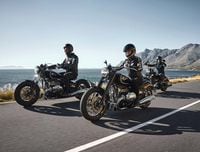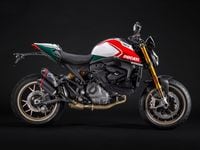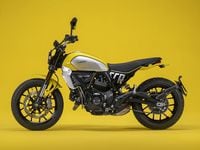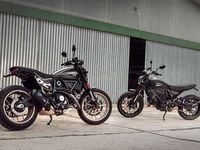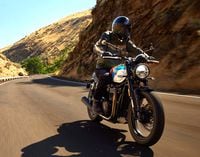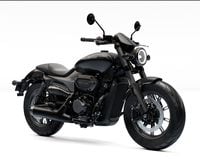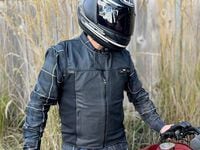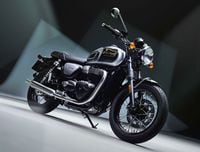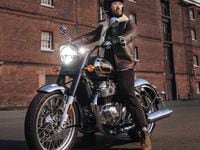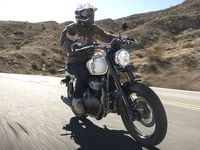It's the biggest clear-cut class in motorcycling.
Five companies offer eight different enticements for the dollars of buyers looking for a middleweight V-twin motorcycle. With that many possibilities, just keeping track of what's available can be difficult.
When we launched this magazine at the beginning of 1996, an 800cc comparison was already on our editorial plan. After all, there were five motorcycles available in the class: Harley-Davidson's popular 883 Sportster (then available in three slight variations); Kawasaki's Vulcan 750 and Vulcan 800, Suzuki's Intruder 800 and the evergreen Yamaha Virago 750. By the time our first issue was ready for press, the list had grown to six when Kawasaki expanded its offerings to three with the introduction of the Vulcan 800 Classic. By the time that bike was available, we learned that a new Suzuki was on the way. That was the Marauder, released early this year. Before the Marauder was available, Honda announced that it would introduce its long-awaited entry, the Shadow American Classic Edition 750 (in two slight variations), this past spring. With all the contenders gathered at last, we began to size them up.
The machines in this class can be divided into sub groups. The Suzuki Intruder and Kawasaki's original Vulcan 800 (a.k.a. the 800A) share a common styling approach with their skinny front tires and chopperesque lines. The currently popular wide look is given form by Honda's new A.C.E. 750, the Kawasaki Classic and Suzuki's Marauder. At the other end of the trendiness scale are the original V-twins from Yamaha and Kawasaki, the Virago and Vulcan 750 respectively. These two, originally introduced in the early 1980s, were designed while Japanese stylists were still groping with the problems of meshing Asian technology with American styling tastes. The final styling variant is represented by Harley's Sportster, which plays its own song and won't fit neatly into any of the conventional styling niches.
But the machines must all tackle roughly the same mission. They need enough power and comfort to provide serious transportation and fun for any experienced rider, whether his requirements entail riding across town or across the state.
All eight also serve the new or "companion" rider. In other words, with their low saddle heights, modest bulk and weight, manageable power characteristics and friendly handling, they are designed to lure first-timers or passengers, mostly women, who want to take the handlebar into their own hands. They should be versatile. And they should carry off this act with street-smart style.
The problem, at least from the standpoint of a magazine tester, is that all eight motorcycles accomplish their common mission successfully. Each one has strengths and weakness. Ranking them became a formidable task.
The Way You Look Tonight
First impressions always come through your eyes, and the two Vulcan 800s, the Shadow A.C.E. and the Intruder made the most style points. The Honda profile elicited praise from virtually everybody, with the Vulcan Classic a close second. However, some people still have a warm spot for the chopperesque style of the Intruder and Vulcan 800A. The dated styling of the Virago and Vulcan 750 left most riders cold, though even they had a few admirers. The Sportster found both admirers and detractors but it got none of the wows that greeted the Shadow, for example. Said one rider, "Form follows function on the Sporty. There's no goofy plastic covers or billet-look beauty panels. It's an honest machine and beautiful for it." Those remarks about plastic covers and imitation billet refer particularly to the Marauder, and to a lesser extent, the A.C.E., both of which prompted the 10 riders involved in the test to comment about some of the plastic pieces. The Intruder and the Vulcan 800s held up the best to detailed inspection, with little plastic.
As soon as you get on a bike, its appearance becomes secondary. The farther and more frequently you ride, the less appearance matters. But ergonomics turned out to be almost as personal a matter as appearance in this class. Take the 883 as an example. The high, somewhat rearward placement of the foot pegs and short (28.7 inch wide), low handlebar suited riders five-foot-six and under perfectly, but riders over five-foot-ten said it folded their legs up too much, making them feel cramped. However, everyone liked the low bar at highway speed, where it minimized wind pressure. With the Shadow, the situation was reversed. Our shortest rider called it too big, though tall riders felt it was comfortably roomy. The wide (33.4-inch) bar created a problem for just about everyone though, since it not only spread you out in the wind like a sail but became awkward while making full-lock turns at parking-lot velocities. Shorter riders had trouble reaching the outside handgrip in a full-lock turn and taller riders discovered that the inside bar end hit their knees.
Shorter riders also complained about the height of the handlebars on the Intruder and, too a lesser degree, the Vulcan 750, though none of the bikes were too tall for them. Oddly enough, taller riders also felt cramped on those motorcycles also, especially the Intruder with its pullback bar. The Intruder's riding position is more feet-forward than the Vulcan 750, which places its footpegs back further than most of the other bikes. The Intruder bar places the grips at a more vertical angle than any other bike here, which requires you to grip the bars, not just hook your hands around them to hold on at high speeds. The Vulcan 750 bar is an uninspired, very 1970s bend with few swoops but significant rise; it puts the grips at a comfy angle, just a bit higher than most riders preferred and too close to the seat for bigger riders.
There were some happy mediums, however. Everyone liked the riding positions of the Virago and Vulcan Classic. The Virago has an unusual handlebar shape, but the grips end up in place that's comfortable for everyone and neither too vertical nor too pulled back. The position and angle of the Classic's handlebar ends gave it an edge over the 800A for most riders. The Marauder and Vulcan 800A also worked for most riders, though the bar-peg relationship wasn't quite as comfortable as on the Classic and Virago. The lowish bar on the Marauder leans you into the wind slightly, though not as much as the Harley. On the highway, most riders soon put their feet on the passenger pegs, in part because the seat and handlebar position invite it and partly because its passenger pegs easier to reach than the rest.
A few unique annoyances cropped up. The Virago's rear cylinder get hot enough to make your leg uncomfortable despite a heat shield. One rider had a similar complaint about the Vulcan 750. The narrow Sportster tank displeased some riders, who also complained that the protruding air box was an uncomfortable leg rest.
Sit On It
It was easier to get a consensus about seats, though bigger and heavier riders placed greater emphasis on saddle quality.
The Virago's saddle met with universal praise. The saddles on the A.C.E., which is the widest and fairly flat, and the generously padded, but somewhat narrow Vulcan 750 were also well received. The only complaint about the Honda saddle was that it forces taller riders to sit a bit more forward than they like. The Kawasaki 800s were almost as good and some riders rated them highly. Smaller riders, who sat in the middle of it, liked the Marauder saddle, but taller riders sitting at the rear quickly felt uncomfortable pressure from the protruding latching mechanism under the saddle. The Intruder seat was too narrow for almost everyone, crowded larger riders and is also thinly padded. Our Harley was a special case, since, having experienced the standard small solo saddle, we didn't want to deal with it again. We arranged to have our test unit fitted with the accessory dual saddle, which is flat and comfortable in shape, though thin padding made it a bit hard for larger riders on long rides.
Though none of these make great passenger haulers, the seats on the Kawasaki 800s seemed to be the best received by back-seaters, with the Honda and Yamaha also getting good marks. Some passengers were drawn to the Vulcan 750 and Intruder by their small passenger backrests, but better accessory backrests are available for all of these machines.
Everyone noted that the Sportster vibrates the most, especially through the handlebar, though this annoyed some riders more than others. The Honda was rated the smoothest by everyone. The Kawasaki 750 and Yamaha also prompted notes about their vibrations from multiple riders, with the rest getting a single note each about their buzz.
Depending on the moment's mission, most of the suspensions drew praise or criticism. Only the Honda suspension provides both a compliant ride over bumps and steady handling in sweeping corners. Revised rates in the Harley give it stone-steady handling in smooth corners, and it out-scored the other seven in twisty-road competence. However, its tautness and limited travel turned into a liability when the road was bumpy. It delivered the harshest ride in this group, and big bumps in corners required a degree of circumspection. The Suzukis, Kawasakis and Yamaha, have softer suspension, which provides significantly smoother passage over rough spots, but also allow those machines to wallow in fast, sweeping corners. The Vulcan 750 and Intruder were the worst in this regard. The Intruder exhibits the most chassis flexibility, and the VN750 has the least effective damping, which lets the suspension continue to pump after encountering a bump or other load in a corner. This shortage of damping makes these bikes wallow. The softness of the suspension, particularly on the Virago, and to a lesser degree the Vulcan 750, leave you with little suspension travel after you load a passenger onto the back seat.
None of these 800s are exemplary in gusty cross winds, though again, the Intruder and Vulcan 750 seemed to be affected the most. On winding roads, the Sportster led the league in cornering clearance, with the Honda dragging before any of the others. In terms of steering manners, the Virago, Shadow and Sportster were the most neutral and predictable. However, the margin here was very small; no one complained about any of the machines. The wide bars make the Shadow easy to man-handle at tip-toe speeds-up to a point. The Intruder's skinny front tire and low overall weight make it feel quite light and manageable at an ultra-slow pace, though it is also slightly floppy. The Marauder, which weighs just slightly more, doesn't feel quite as light.
Just Stop It
We expected the only bike here with a disc rear brake to have an edge when it was time to stop, but the Sportster's rear disc brake proved a bit too sensitive. When the group had to make a hard stop, the Harley was the one that locked up the rear wheel first. There wasn't much to separate the single-leading-shoe drum rear brakes of the other seven, especially since they also have similar tire compounds, though the the Honda seemed slightly touchier than the others, despite having the widest rear wheel in the crowd.
Still, the front brakes are the critical ones in a hard stop, and there are a number of good ones here. The A.C.E., Marauder, Virago and Vulcans 750 and Classic all did the job quite well, delivering strong power with good feel and feedback -- the Yamaha and Kawasaki 750s because they have dual discs, the others because the use dual-piston brakes. The Classic required a stronger squeeze than the others. The VN800A and Intruder felt mushy, but both provided reasonable power despite the feel, especially with the light Intruder to stop. The Harley front brake also has good power and control -- provided your hand is big enough to grasp the lever. Riders with smaller dukes had to choke up on the lever to get their fingers around it, losing power and control in the process.
Of course, suspension also plays a part in braking. The softly sprung XV and VN 750s dive hard in rapid stops. The Honda and Harley dove less, making them more stable in panic stops.
Eight To Go
Before you stop, you have to go. There is no particular effort required to start any of these eight, although the handlebar-mounted chokes of the Virago and Vulcan 750 are handy on cold mornings. None of the bikes is particularly cold-blooded and most will start without choke on warm days. However, once warmed up, the two Kawasaki 800s are a little balky off the bottom, presumably because they are a bit lean. This was more apparent on the 800A than on the Classic. Our Harley also carbureted unevenly, sometimes stumbling when given a full helping of throttle suddenly.
One of the most clear-cut differences among the bikes was in power. The Intruder just runs away from the other machines, especially the single-carb models. No matter what the speed, if you open the throttle on the Intruder, you immediately zip past the other bikes. Some of the single-carb bikes can't keep up with it even if downshifted a gear. What surprised us the most is how much slower the Marauder -- which is supposed to have the same engine as the Intruder and a more efficient chain drive -- is in comparison, at least in all-out sprints, where it falls behind the second-faster Vulcan 750 and the Virago.
The Marauder does better when the race starts in top gear; in that event the Marauder is stronger than anything except the Intruder. Among the single-carb bikes, the Kawasaki's were slightly better performers. Honda's new Shadow A.C.E., which has the least displacement in the class by a few cubic centimeters, is the slowest member of this club. But displacement isn't the answer, since the Sportster, with a 10 percent advantage in engine size over the next biggest machine, was barely faster than the Honda. The slower bikes' acceleration suffers in part because of their tall gearing, which makes them feel more relaxed at highway speeds than the others.
An area where the Sportster out clearly performed all the others -- due in part to its tall gearing -- was fuel mileage. The Harley was the only bike that consistently broke 50 miles per gallon out on the highway. That still wasn't enough to give it the greatest cruising range in the group, because of its smallish 3.3-gallon tank (though it's a major improvement over the 2.25-gallon it replaced). Despite just average fuel mileage, the Kawasaki 800s, with their 4.0-gallon tanks (the biggest here), can go slightly farther between fill-ups, according to our calculations. The Intruder, with the smallest tank (3.2 gallons) and only average mileage, will normally need to be replenished with fuel after the fewest miles.
The bikes all shifted well, though the Honda was the smoothest gear-changer here. Typical of the breed, the Harley was the noisiest shifter in the group, but it resisted our attempts to make it miss a gear. One rider found the Marauder shift lever a little short for his feet, and others wished for slight adjustments to the shift levers. Finding neutral on the Harley could be a little tricky, though it dropped right in if you selected it before coming to a complete stop. The automatic neutral finder of the Kawasakis, which prevents the transmission from shifting up past neutral when you're at a stop, simplifies this chore, although the Vulcan 750's neutral light didn't always know it was in neutral. No one complained about ratio staging on any of the bikes, though the Intruder and Vulcan 750 seem the busiest when running down the highway in top gear.
To live up to their requirement for manageability, these machines must provide light, progressive clutches. The Harley requires a heavy pull, which elicited complaints from riders with smaller hands. It did engage smoothly though. The Marauder worked well when pulling away normally, but rolling away briskly with lots of throttle and rpm made it grab. Lash in the Virago's drive train showed up as abruptness in clutch engagement during high-power departures. This may be a damper somewhere in the drive line that bottoms out. The rest of the clutches prompted no complaints either for disengagement pressure or controllability.
While on the subject of power trains, it's worth noting how they sound. Everyone has his own favorite cadence and tone, but there was general agreement that the Sportster, thanks to its new, less restrictive mufflers, sounds better than ever and better than any bike here. It also seems to make less mechanical noise than it used to. The exhaust note of the Virago also drew appreciative comments. The Honda was quite quiet at idle but found its voice, and a pleasant one, under load.
Problems
We had a few minor mechanical difficulties with the bikes.
The 750 Vulcan had an intermittent electrical connection. Occasionally it would fail, leaving the tach, horn and instrument lights inoperative. Wiggling the instrument panel or turning the ignition on or off solved the problem.
When running at high (above legal highway) speed, the Intruder would occasionally slow down; we believe the problem was caused by a fuel-flow problem.
The Virago's low-oil-level warning light came on for several minutes at one point, scaring the rider, even though the bike had plenty of oil.
Our Marauder, which is the same bike we tested for our February issue, lost its tool kit during that original test. The problem was caused by the design of the toolbox, which uses a screw-on sheet-metal cap. The location of the cylindrical toolbox above the transmission means that it gets rattled by the engine. Vibration simply loosens the cap, which falls off. The tool kit follows a short while later. During this test, we confirmed that it wasn't an isolated problem, as we lost two more tool kits and toolbox lids. (We have heard of other Marauders that had the problem.) The last cap that departed the bike was taped in place and still came loose. This is not only aggravating, it's dangerous because the tools can hit someone riding behind you. In our opinion, Suzuki should redesign the toolbox -- which looks dated anyway -- at the earliest opportunity. We also believe that the lids and tool kits should be replaced under warranty, since it's obviously a design defect. At least the Marauder starts out with a tool kit; the Sportster has none and no place to store one. Figure on spending in excess of $100 for a kit and a carrying bag if you want one on an 883.
In the 1000 miles or so we put on each bike, none used a significant quantity of oil or required any other routine maintenance, even chain adjustment. However, wiping chain lube off the rear tires and fenders of the Shadow, Marauder and Vulcan 800s did get old quickly, though the Marauder's cast wheels were easier to clean than the wire wheels on the other three.
We like the looks of wire wheels but cast wheels have other functional advantages. Most notably, they can mount tubeless tires, which tend to lose air more slowly when punctured than a tube-type tire. A punctured tube can deflate rapidly or blow out, creating a possible control problem. Spoked wheels also require occasional maintenance.
Sweating the Small Stuff
These machines offer a variety of maintenance-reduction features. The Vulcan 750, which includes shaft drive and hydraulic valve adjustment along with the usual amenities -- automatic cam-chain tensioning, fiddle-free electronic ignition, and a spin-on oil filter -- seems to ask the least from its owner in terms of maintenance. The Sportster also offers a no-adjustment-needed valve train, and the Harley's belt drive seems to need less maintenance than a chain (and requires no messy lube). The Harley and Kawasaki 800 air cleaners are the easiest to service. The VN800 air cleaners mount alongside the engine like the Harley and are accessible by removing single nut; the 883 has two screws. Honda also placed the A.C.E. 750 element in the chrome plastic oval pod on the right side of the engine, but you must remove six screws to get at the element, which occupies just a fraction of the volume of the airbox. Intruder 800 owners complain about the difficulty of reaching the battery, which is located down under the swingarm. The centerstands of the Vulcan 750 and Virago simplify almost every aspect of maintenance and are especially welcome when you must remove a wheel.
In terms of day-to-day usefulness, each bike had minor points we liked and some didn't. The tank-top speedometers of the Vulcan 800s require you to take you eyes off the road to check them. Speedometer accuracy at 50 mph varied from just over one mph optimistic on the Sportster and Intruder to almost 5 mph on the Vulcan 750, which adds up after a full day at high speeds. Several riders appreciated the tachometers of the Vulcan 750 and Virago. We also liked those bikes' dual horns, with the Virago actually providing a serious amount of noise, unlike most bike horns.
The Vulcan 750's center-to-cancel turn-signal system is dated and a bit awkward. However, everyone preferred it to the self-canceling two-button Harley turn-signal system, which cancels too soon around town and not soon enough on the highway and leaves us unsure of whether it's still flashing or not, especially since the Harley instrument lights are so dim. The Yamaha also has self-canceling turn signals, but it uses a single switch with a push-to-cancel design. Though one rider didn't like the self-canceling feature which he felt removed control by turning off whether he wanted it to or not, most of the other testers appreciated it on the Yamaha. The rest of the 800 twins have standard push-to-cancel manual switches. The tinted mirrors of the Sportster reduced visibility at night, and the round mirrors on the Shadow and Marauder reduced your angle of view compared to the horizontal shapes of the other mirrors, which let you see across two lanes behind you.
These machines offer different levels of standard theft deterrence. In standard form, the Sportster has nothing more than an ignition switch, though there are lugs on the steering head and frame to lock the fork with a padlock. (However, you must then find a way to carry the padlock.) The Vulcan 750 and Virago combine fork and ignition locks in a single unit atop the fork crown. Although we like this ignition lock location and being able to turn off the bike and lock the fork in a single motion is handy, it's also convenient for thieves, who only need to slide-hammer a single easy-to-reach lock to ride away on your bike. Of course, these two bikes probably are probably much lower on thieves' most-wanted list than Sportsters. The rest of the bikes have separate ignition and fork locks, but on the Suzukis they also use different keys, which serves no useful purpose that we can think of (unless you have to replace one of the locks, in which case it saves you from buying the whole set).
Behind the 800 Ball
After accumulating a total of more than 10,000 miles between the eight 800 twins, there are some winners but no dominant, head-and-shoulders-above-the-rest victor. Personal preference pulls everybody a different direction, as the accompanying personal ratings chart reveals. In a couple of cases, a bike that got the highest rating from one rider received another rider's lowest score. This emphasizes how important it is to try before you buy. If you can't get a test ride, at least be sure you take a leisurely test-sit.
The bikes that got consistently strong reviews were the Honda and the two Kawasaki 800s. Though underpowered in comparison to the other seven and bedecked with a bit more plastic than we'd like, Honda's new Shadow A.C.E. 750 was comfortable for all but our smallest rider and turns more heads than any of the others. Good handling and strong brakes complete a well-executed package which comes with a palatable price.
Kawasaki's two 800s also put on a good all-around performance, offering comfort, steady handling, pleasing styling and clean detailing. Though stronger than the Honda, they are still slow by comparison to the twin-carburetor machines. However, the price of the VN800s is a bit high for what they deliver. If they had shaft drive systems, the price would be in the ballpark. The Classic in particular, at over $1000 above the rest of the field, seems pretty pricey. The Vulcan 800A, which is $800 less than the Classic despite having comparable equipment, is more reasonable.
Two riders picked the Yamaha Virago as their favorite bike here. With strong power, comfort equal to or better than any of the other bikes, exceedingly neutral steering and an extensive equipment list, which includes shaft drive, the Virago offers plenty for anyone who likes its looks -- which isn't everybody.
Though a bit cramped for tall riders who scored it accordingly, the Harley appealed to smaller riders. Improvements to suspension rates have paid dividends, allowing the Sportster to live up to its name. Power isn't impressive and standard equipment is quite Spartan, but the low price tag provides an excuse and leaves budget to fix those things -- assuming you can find a dealer who will sell one for the suggested price. Still, it vibrates more than any bike here, which isn't easily fixed and proved a major annoyance to some riders. "I like the rumble but not the shake," said one novice. It enjoys the best parts and accessory support of any bike in the class.
Despite its class-conquering power -- which enables it to out-run some big twins and all the 800s -- and tremendous attention to detail, Suzuki's Intruder pays for its chopper-style lines with cramped ergonomics and a somewhat flexible chassis. And, though some riders love its look, others are unimpressed. The price is definitely right for a bike with so few cost-cutting measures and shaft drive, but the Intruder itself is not right for everyone. The aftermarket supports it better than any of the other Japanese-brand machines.
In comparison to the Intruder, it seems that Suzuki spared no expense in cutting corners on the Marauder. The basic look is pleasing and original, but chintzy pieces are everywhere you look. A surprising amount of power has been lost in the translation from the Intruder, but it offers greater roominess, steadier handling and better brakes than its stablemate. The price is also an attraction, especially if you get to keep the tool kit.
Despite a strong-running engine, a comfy saddle and the most extensive list of standard features -- which includes meaningful functional attractions like shaft drive, no-maintenance valves and a centerstand -- Kawasaki's Vulcan 750 slips to last in this group. Though two riders rated it among their top picks, others were put off by the unsophisticated styling and mushy suspension.
When you factor in all aspects of these bikes and different riders reactions to them, the difference between first and last is surprisingly small especially when you consider they were designed by five different companies over a decade and a half.
None of the bikes were given abysmal scores by any of the riders, and only one rider gave one bike a very strong score.
Though the 800 twins don't push the same hot buttons as some of their big-displacement counterparts, none of them is a complete toad either. In traffic or under smaller riders, these are much handier bikes than most big twins. Any one of these eight can provide dependable transportation, whether it's for a weekly run downtown, a daily 100-mile commute or a long-distance summer trip.
Our 800 round-up has been a long time in coming, but finding eight such solid, versatile machines made the wait worthwhile.
HIGH POINTS. LOW POINTS & FIRST CHANGES
Harley Sportster
High Points: Affordable, good suspension, solid handling, great fuel mileage
Low Points: Vibration, unimpressive power and carburetion, uncomfortable standard seat, limited standard equipment
First Changes: Install dual seat, add passenger pegs
Honda 750 ACE
High Points: Smooth engine, great looks with original touches, roomy accommodations, good suspension
Low Points: Down on power, chain drive, too much plastic
First Changes: Install narrower handlebar
Kawasaki Vulcan 750
High Points: Comfortable saddle, strong power, shaft drive, many useful features
Low Points: Gives ugly a bad name, mushy suspension
First Changes: Improve suspension, change to lower handlebar
Kawasaki Vulcan 800A
High Points: Well executed styling, comfortable version of chopper style, comfy riding position for most riders, smooth engine
Low Points: Low-speed hesitation, chain drive
First Changes: Jet kit
Kawasaki Vulcan 800 Classic
High Points: Well executed styling, comfortable for rider and passenger, smooth engine
Low Points: High price point, low-rpm flat spot, chain drive
First Changes: Jet kit
Suzuki Intruder 800
High Points: Class-conquering power, well detailed, real-steel design, smooth shaft drive
Low Points: Cramped riding position, wallows in corners, narrow saddle
First Changes: Aftermarket saddle, maintenance-free battery
Suzuki Marauder
High Points: Affordable, original styling, steady and predictable handling
Low Points: Total-loss toolkit design, way too much plastic, seat protrusion prods average to tall riders, down on power compared to Intruder, grabby clutch, chain drive
First Changes: Secure toolkit lid, trash rear fender reflector, better saddle
Yamaha Virago 750
High Points: Excellent ergonomics please everybody, great seat, strong power, shaft drive
Low Points: Unfinished look to engine plumbing, soft suspension permits wallowing
First Changes: Tauter suspension, replace ugly oil-line hose clamps
800 V-TWIN SCORECARD
Although there were 10 riders involved in this test, some (such as an advertising salesman) had conflicts that kept us from using their rankings of the bikes and others did not get to ride them enough to form solid conclusions. We ended up with five riders for our scoring. Their score sheets and comments follow.
Friedman: If all eight 800s were full-time residents of my garage, the Yamaha would rack up the most miles, with Kawasaki's Classic and Honda newest Shadow tying for second. The Virago is comfortable, has good power and steers exactly the way I like a bike to. More than any of the others, the Yamaha invites me to ride.
The Sportster would get some attention too. I'd ride it when twisting roads beckoned, but it would also be the one I fiddled with. It would make a great project, with infinite possibilities for customizing and hopping up.
As for the other four, I'd probably ride the Intruder and the Vulcan 800A occasionally, when my mood suggested one of them. I suspect that the Marauder and the Vulcan 750 would just sit. The VN750 doesn't do anything that the Virago doesn't do as well or better, and the Marauder, with all the plastic pretend stuff, doesn't seem to want to be taken seriously.
H-D 3.0, ACE 3.5, Vulcan 750 2.0, Vulcan 800A 3.0, Classic 3.5, Intruder 3.0, Marauder 2.0, Virago 4.0
Art Friedman
Friedman, who has been testing motorcycles for publications for over 25 years, stands 5-foot-10 and weighs 185.
Han: Rating these bikes is a daunting task. I have never witnessed such heated debates over motorcycle styling.
Performance suddenly was not the deciding factor and ergonomics differed dramatically from rider to rider. Believe me, I tried to find that uncomfortable bump in the Marauder's seat but failed. As a result, the Marauder tied with the Shadow A.C.E. near the top of the bunch. But, before I get into my favorites, let's talk about what I didn't like because I'm a female and I like to complain.
The Vulcan 750 was a bore: boring ergos, boring looks, and boring motor. The Virago 750 was a step up, but still suffered from vanilla ice cream syndrome. And for 6K, I can do better than blah. Suzuki produced both a hit and a miss. The Intruder had the best to power of the group, but looks like it is trying too hard to be cool. Pass. Bring onthe Marauder instead. This bad boy projects attitude. It was fun in the twisties, manageable in traffic, and comfortable for me on the long haul.
The Shadow was a pleasant surprise. I expected the wide handlebar to make handling cumbersome, but the Shadow felt light and responsive. The Vulcans 800 and 800 Classic are good overall packages with good handling and looks to boot. But their prices and lack of low-speed guts keep them off the top of my list.
One bike stood headlight and seat above the rest. The Sportster is in a class all by itself. For just over $5K, you get the most versatile package in the 800cc class. Great handling and torquey low-end punch make the Sportster fun to ride. And you'll have the bucks left after the purchase to make the Sporty your very own statement. Granted, this may not be the route for you. In which case, the Marauder or Shadow can take you straight from the showroom floor to the asphalt jungle in a matter of minutes. (It may be a little longer for the Marauder since you'll have to fix the toolkit.)
H-D 4.5, ACE 4.0, Vuncan 750 2.0, Vulcan 600A 3.5, Classic 3.0, Intruder 2.5, Marauder 4.0, Virago 2.0
Jenny Han
Han, a motorcyclist of five years, is Associate Editor for _Hot Rod Bikes. She stands five-foot-six and claims to look like a stegosaurus._
Ramlow: This class has much to offer, though the 800s are not, in my opinion, for everyone. They are not for people who shop for clothes marked XL, travel long distances or have lots of riding experience and a hankering for power.
If price was not an issue, my first choice would be the Kawasaki Classic, but since the Kawasaki 800A is just as solid and comfortable, I'd buy it. The Honda would get some consideration too, though a little more steam would be nice along with some bars that didn't spread my arms so wide.
I was impressed with the clean lines and improvement in quality control on the Harley, but it's much too cramped for my 5-foot-11 frame, power is down, the clutch is unnecessarily stiff and it is paint-shaker smooth.
Ron Ramlow
Ramlow, a veteran motorcyclist with over 30 years of experience on- and off-road, is a frequent participant in _Motorcycle Cruiser tests._
H-D 2.5, ACE 4.0, Vulcan 750 3.5, Vulcan 800A 4.0, Classic 4.0, Intruder 3.0, Marauder 3.0, Virago 3.5
**Piper: **My mother always told me that I was too picky. Thus it's no surprise that if I had my druthers, I'd be stealing parts from each of these bikes to assemble one great 800 cruiser. Hmm, let's see. The power of the Intruder with the upright styling and handling of the Sportster? Or wait, how about the clean lines of the Kawasaki Classic with the cushy seat of the Virago?
But I suppose it's a bit much to expect perfection. I selected a keeper based on how well the positives fit what I want in a cruiser. These wants are: looks, responsive handling, power and comfort. I found these elements in the Virago. Sure, it had its problems, like being a little wobbly at high speeds in the sweepers. But besides being just a downright pretty bike with the cushiest seat of the bunch, it had power and it had responsive handling. Frankly, I felt as comfortable riding this bike on challenging mountain roads as I did in town skipping around cars. Yep, I'd be happy to add this bike to my collection.
H-D 3.5, ACE 3.5, Vulcan 750 4.0, Vulcan 800A 3.5, Classic 3.5, Intruder 4.0, Marauder 3.0, Virago 4.0
Elisabeth Piper
Piper is a California Motorcycle Safety program instructor.
Brasfield: This selection of twins provides a varied playground for someone who has multiple personalities, like myselves.
Meet Mister Twisties: Although the Sporty looks and feels more like a standard to me, it's in this comparison and gets my vote for any winding road. The 883 may be dog slow off the line, but it has good ground clearance, firm suspension, predictable (but heavy) steering, and strong brakes, all of which allow speedier corner entries. As long as the tarmac turns, you won't be able to separate me from this bike, but let the road get straight at anything approaching highway speeds and the solid mounted engine forces a different personalities to reveal himself.
Enter Jess Gassit: I first became aware of this prankster after we trounced all the other 800s in roll-on races. I could hear him cackling inside my helmet taunting the other riders on lesser machines. The blunt instrument he'd just beaten the poor sods with? Why the Intruder 800, of course. The Intruder does one thing exceptionally well -- it accelerates. The powerful engine makes it possible for me to ignore how the seat shape keeps us from sliding back far enough to avoid feeling cramped. Also, the skinny front tire and wimpy frame conspire on high speed corners to make the Intruder wobble. But all of those thoughts disappear when the road straightens and the carburetors' butterfly valves head towards horizontal.
Welcome Classy Cruiser: This guy knows cruisers are about style and attitude, not just performance. He thought at the beginning of this comparison that the Vulcan 800 Classic would be a shoo-in as his personal favorite. However, the Honda didn't agree with my initial assessment. Every time I rode one of these two I crowned it the winner, only to change my mind on the next ride. Both bikes have the look I favor, a comfy seat, good brakes, and a suspension that straddles the appropriate compromise of plushness and firmness for cruiser duty. Yes, the Honda does feel underpowered at times, but the Classic's exhaust note left me cold.
What settled the decision? Price. The money saved could buy a lot of accessories for the Honda--like some chrome to cover those ugly allen bolts on the gas tank and some real billet O-ring pegs for starters.
In case you wonder which of my personalities is the dominant one, I say, let the boys play with their toys. It's Friday evening; Karin and I will ride the Shadow to dinner and a movie. Later? A moonlit ride home. That's cruising.
H-D 3.0, ACE 3.5, Vulcan 750 3.0, Vulcan 800A 3.5, Classic 4.0, Intruder 3.5, Marauder 3.5, Virago 3.0
Evans Brasfield
The various Brasfield were Associate Editor of _Motorcycle Cruiser and an instructor for the California Motorcycle Safety Program at the time this test was conducted. He stands six feet tall in his boots. You can reach him through his website: www.EvansBrasfield.com_
HARLEY-DAVIDSON
Sportster 883 (XLH883)
The best-selling motorcycle in this group was originally conceived 40 years ago, when the first Sportster, an 883cc overhead-valve 45-degree V-twin design not terribly different from this one, was rolled out as Harley's answer to the new high-performance bikes coming from England. The present configuration -- alloy "Evolution" top end, hydraulic lifters, and a couple hundred other changes -- was introduced for 1986. A five-speed transmission (instead of four) and belt final drive (replacing a chain) were incorporated a few years later. Harley's 1200 Sportster is essentially the same except for wider bores and some gearing changes.
Last year there were three 883 Sportster models: the base model with a solo saddle, no tachometer and a bargain price; the Deluxe model with tach, passenger seating and pegs; and the Hugger, essentially the base model with shorter shocks and a buckhorn handlebar. This year the Deluxe model is gone. We requested (and got) a dual saddle and passenger pegs on our base model, which also came with Harley's optional wire-spoke wheels laced to new machined hubs in place of the standard cast wheels.
Nothing in this class looks, feels, rides or sounds like a Sportster. If you blindfolded any one of the riders involved in our comparison asked them to sit on the bike with the engine silent or simply listen to it, they could identify it without hesitation. The other bikes in the group would require at least a moment of consideration.
Though its profile is unmistakably that of a cruiser, the Sporty is still unlike anything else. It's lithe, yet more aggressive and sporting in profile than the chopper-style bikes. The low bar, unique tank shape, and dominant engine appearance distinguish it from all other machines. The riding position is distinctively different from the other seven bikes in this group.
Like its progenitors, the 1997 Sportster engine transfers engine heat directly to the air it brushes through; no liquid-cooling or fake fins here. No overhead cams, either. Two cams down in the crankcase operate roller followers and pushrods to open the two valves that move mixture through each cylinder. A single constant-velocity carb with an accelerator pump mixes the incoming fuel and air and also provides the basis for the much-imitated chrome airbox on the right side of the engine. Unlike other bikes with a similar design, Harley uses no fancy intake plumbing obscured by the airbox, just an air filter, Keihin carb and a Y-shaped manifold. Nor are the drive components like the other machines in this crowd.
Dry-sump lubrication means that oil is carried in a tank on the right side of the bike rather than in the crankcase, where the level is easy to check on the sidestand. Instead of the gear primary drive used on the other bikes, the Harley transfers power from the single-pin crank with a triple-row chain. It's also the only bike here with a belt final drive, which combines the cleanliness and quiet of a shaft drive with the weight and efficiency of a chain.
For 1997, the 883 got a smaller battery, which also is maintenance-free, offers an additional amp-hour capacity and pumps out more cold-start power. The mufflers are a bit less restrictive, for an audible improvement in exhaust note and perhaps power, and the suspension damping rates have been recalibrated to improve ride and handling. The Sportster in the only bike in this group with disc brakes at both ends.
That distinct approach continues throughout the straightforward chassis. Except for that Sportster trademark, the polished "eyebrow" above the headlight, there is no extraneous, non-functional piece evident anywhere. This year the fuel tank has grown an extra gallon to 3.3 gallons, but its unmistakable profile remains. Unlike the other bikes, the fuel cap doesn't lock. Neither does the steering head, though there are lugs for a padlock. There's no toolkit either -- and no place to store one. It's the only bike ere without a helmet lock. The stark approach also shows up in some details, such as many of the fasteners. Unlike the Japanese contenders, which use polished bolts heads and chrome nut covers, the Harley uses rough-finished fasteners which look sort of industrial. However this, as with almost every other XLH shortcoming is addressed by the aftermarket, which offers more accessories, cosmetic enhancements, modifications and improvements than for the other seven bikes in this group combined.
Harley's Spartan approach to the Sportster pays off when you get to the bottom line. A plain black 49-states Sportster 883 will set you back a mere $5195 suggested price, though by the time you add our sample's pearl paint ($150), wire wheels ($320), dual "Sport" seat ($170), passenger pegs ($40), and maybe a toolkit to put yourself on a par with the other bikes, you are approaching the price of the Marauder. Of course, you still have the option of deferring that stuff to a later date. That assumes that your Harley dealer doesn't want you to pay a premium for the privilege of buying it.
Specifications
1997 Harley-Davidson Sportster 883
Designation: XLH 883
Suggested base price: $5195 ($5315 California)
Standard colors: black
Extra cost colors: pearl red, pearl blue, add $150
Standard warranty: 12 mos., unlimited miles
Recommended service interval: 5000 miles
ENGINE & DRIVETRAIN
Type: air-cooled 45-degree tandem V-twin
Valve arrangement: OHV; 1 intake, 1 exhaust valve; operated by pushrods, hydraulic adjusters
Displacement, bore x stroke: 883cc, 76.2 x 96.8mm Compression ratio: 9.0:1
Carburetion: 1, 40mm Keihin CV
Lubrication: dry sump, 3.0 qt., spin-on filter
Minimum fuel grade: 87 octane
Transmission: wet multiplate clutch; 5 speeds
Final drive: belt, 61/27
CHASSIS
Wet weight: 524 lb., 52% rear wheel
GVWR: 948 lb.
Wheelbase: 60.2 in.
Overall length: 87.6 in.
Rake/trail: 29.6 degrees / 4.6 in.
Seat height: 28.0 in.
Wheels: cast, 19 x 2.15 front, 16 x 3.00 rear (wire-spoke add $320)
Front tire: 100/90-19 Dunlop Elite D401
Rear tire: 130/90HB16 Dunlop Elite D401
Front brake: single-action caliper, 11.5-in. disc
Rear brake: single-action caliper, 11.5-in. disc
Front suspension: 39mm, 6.1 in. travel
Rear suspension: dual dampers, 3.62 in. travel, adjustment for preload
Fuel capacity: 3.3 gal.(.5 gal. reserve)
Handlebar: 28.7 in. wide, 1.0 in. diameter
Inseam equivalent: 33.0 in.
ELECTRICAL & INSTRUMENTATION
Charging output: 297 watts
Battery: 12v, 20AH
Forward lighting: 55/60-watt 5.5-in. headlight, position lights
Taillight: 1 bulb
Instruments: Speedometer, LCD odometer/tripmeter; warning lights for neutral, high beam, low oil pressure, left turn signal, right turn signal
PERFORMANCE
Fuel mileage: 45 to 59 mpg, 53.0 mpg average
Average range: 175 miles
RPM at 60 mph, top gear: 2950
200 yard, top-gear acceleration from 50 mph, terminal speed: 71.0 mph
Quarter-mile acceleration: 14.77 sec., 89.9 mph
HONDA
Shadow American Classic Edition 750 (VT750C2)
We have been waiting for this machine to give us a complete set of 800s. We predicted that an 800-class Honda V-twin was on the way in our first issue in 1996, but we expected that Honda would base it on the 800cc V-twin used in the unique Pacific Coast. That engine sprang from the motor created for the original 700/750/800 Shadow, which was last produced in 1988.
However, Honda surprised us by basing the new 750 Shadow on the 583cc powerplant from the Shadow VLX. Bore was widened 4.0mm to 79mm and stroke was extended by 10mm to 76mm, bumping displacement up to 745cc. Much was carried over from the 600 engine: a 52-degree V angle, liquid cooling, a single cam atop each cylinder head prodding one exhaust and two exhaust valves, and even the 34mm carb throat size. Honda says that combining greater flywheel effect from a heftier AC generator with the longer stroke provides better low-rpm power and feel, though we suspect that valve size, lift and duration as well as carb size contribute too.
Of course, plenty of internal components were changed, ias well as the appearance of the engine. The 750 uses two plugs per cylinder, has a 9.0:1 compression ratio instead of the 9.2:1 ratio of the 600 and gets a new emissions-reduction system that injects air into the exhaust ports to ensure a complete burn of the exhaust gases. Perhaps the biggest change is in the drive line, where the 750 gets a welcome fifth transmission ratio, though the transmission is still regarded as a wide-ratio arrangement. However, the final drive still uses a chain.
You won't find many similarity to the 600 in the chassis. Instead of the 600's single-damper hard-tail-style rear end, the 750 uses a pair of shocks with chrome enclosures. A large rectangular-section backbone tube runs from the cast steering head to behind the engine. A rectangular-section swingarm pivots on forged frame sections. Beneath chrome covers, 41mm fork tubes backed up by a brace provide rigidity up front. The wide, low look of the machine starts with a hefty 120/90-17 front tire, mounted on a wire-spoke wheel. It's carried rearward by the full front fender, seven-inch headlight, long, wide 3.7-gallon tank, wide solo saddle, full rear fender and 170/80-15 rear tire. The rear wheel is spoked to a 180mm brake drum. A twin-piston caliper applies friction to an 11.7-inch disc up front. As on the A.C.E. Tourer, the disc has a solid carrier, making it hard to use a disc lock.
In many ways, we rated the A.C.E. 750 as Honda's best styling effort to date. The U.S. version puts the white-face electronic speedometer up near the wide, pulled-back handlebar, which is clamped atop rubber-mounted risers. European versions have the speedo on the fuel tank, which gives the tank a bit more visual weight, especially in profile, but that location was apparently vetoed by American Honda's safety monitors. The U.S. placement puts the speedometer and its warning lights much closer to the rider's line of sight. We were surprised that the chrome shroud on the tank top is secured by hardware-store variety screws, a very un-Honda-like slip.
The passenger saddle is removable, and doing so gives the bike an even lower, longer look. Honda stylists created a pretty new stretched-out headlight shape, nicely curved rear fender rails, and the first billet-style footpegs ever fitted to a mass-produced cruiser, though the actual finish of the metal on the cast pegs is pretty dull, begging for polish and chrome. Rubber rings around the pegs provide traction. The looks of the big oval airbox on the right side of the engine stirred some controversy, especially since it was plastic. Honda also uses plastic for the shroud around the steering head and the side panels.
There are two versions of the A.C.E. 750. Our test sample is the Deluxe rendition, which starts at $6599 in black and includes chrome steel covers for the upper fork legs, chromes engine cases, chain guard and foot controls. Adding two-tone paint as on our sample ups the price to $6799. The standard model, with its forks stark naked, polished engine cases and black paint on those other items, is available only in black for $6299.
Specifications
1998 Honda Shadow A.C.E. 750 Deluxe
Designation: VT750C2
Suggested base price: $6599 ($6299, standard model)
Standard colors: black
Extra cost colors: black/copper, red/ivory, add $200
Standard warranty: 12 mos., unlimited miles
Recommended service interval: 8000 miles
ENGINE & DRIVETRAIN
Type: liquid-cooled 52-degree tandem V-twin Valve arrangement: SOHC; 2 intake, 1 exhaust valves per cylinder; actuated by rockers, screw-type adjusters
Displacement, bore x stroke: 745cc, 79 x 76mm
Compression ratio: 9.0:1
Carburetion: 2, 34mm Keihin CV
Lubrication: wet sump, 3.1 qt., spin-on filter
Minimum fuel grade: 87 octane
Transmission: wet multiplate clutch; 5 speeds
Final drive: chain, 41/17
CHASSIS
Wet weight: 553 lb. 54% rear wheel
GVWR: 917 lb.
Wheelbase: 63.6 in.
Overall length: 97.4 in.
Rake/trail: 33.8 degrees / 6.1 in.
Seat height: 27.6 in.
Wheels: wire-spoke, 17 x 3.00 front, 15 x 3.50 rear
Front tire: 120/90-17 Bridgestone Exedra tube-type
Rear tire: 170/80-15 Bridgestone Exedra tube-type
Front brake: dual-piston caliper 11.6-in. disc
Rear brake: drum, rod operated
Front suspension: 41mm, 5.1 in travel
Rear suspension: dual dampers, 3.5 in. travel, adjustment for preload
Fuel capacity: 3.7 gal.(.9 gal reserve)
Handlebar: 33.4 in. wide, 1.0 in. diameter
Inseam equivalent: 32.4 in.
ELECTRICAL & INSTRUMENTATION
Battery: 12v, 14AH
Forward lighting: 55/60-watt 7.0-in. headlight, position lights
Taillight: 1 bulb
Instruments: Speedometer, LCD odometer/tripmeter; warning lights for neutral, high beam, turn signals, oil pressure, sidestand, coolant temperature
PERFORMANCE
Fuel mileage: 37 to 49 mpg, 43.4 mpg average
Average range: 161 miles
RPM at 60 mph, top gear: 3360
200 yard, top-gear acceleration from 50 mph, terminal speed: 68.2 mph
Quarter-mile acceleration: 15.09 sec., 86.2 mph
KAWASAKI
Vulcan 750 (VN750)
Vulcan 800 (VN800A)
Vulcan 800 Classic (VN800B)
With three distinct models based on two different engines, Kawasaki makes more 800 V-twin models than any other company.
Introduced in 1985, the Vulcan 750 has been around in its present form longer than any of the bikes here except the Virago, and it reflects the fact with all that was good and bad about 1980s-vintage Japanese-brand V-cruisers (although the VN750 is produced in Kawasaki's Lincoln, Nebraska facility). The 749cc engine makes no serious pretense of being air-cooled, and as a couple of testers commented, looks somewhat like a water pump. However, it boasts the most impressive technical credentials in the class, including dual overhead cams (DOHC) with no-maintenance hydraulic valve adjusters for the four valves serving each cylinder. Automatically tensioned dual-stage silent-type cam chains turn the cams. To tame the vibration of the 55-degree single-crankpin design, Kawasaki employs a gear-driven counterbalancer in addition to rubber engine mounts. Two 34mm carbs feed the engine, which exhales through somewhat homemade-looking mufflers, one on each side of the bike.
The five-speed transmission includes Kawasaki's exclusive neutral-finding feature, which automatically goes into neutral when upshifted from first at a stop. Like other early Japanese V-twins, the Vulcan 750 uses clean, quiet shaft final drive and solid, air-tight cast wheels, which permit tubeless tire. The feature list extends to the chassis, where you find dual disc brakes up front and air valves on the rear shocks, to permit adjustments for load.
Though the center-to-cancel turn-signal switch reminds you that not every feature was better on 1980s-vintage cruisers, you soon forget about it when you notice all the extras the VN750 offers. You get dual horns, a centerstand to simplify maintenance, four-way flashers, two helmet locks, a small passenger backrest with the tool kit stowed inside, and the most complete instrumentation in cruising, including a tachometer, coolant temperature gauge, fuel gauge and a bank of warning lights that includes a light that warns if a headlight filament has burned out and automatically shifts to the other beam. Having amortized all that stuff, Kawasaki sells the 750 for a reasonable $6599.
Although they started with the same basic engine layout as the 750 -- the same 55-degree V-angle, 66.2mm stroke and single-crankpin layout with gear-driven counterbalancer -- the 805cc engine which serves in both Kawasaki 800 models, has little in common with the smaller Vulcan V-twin. Though still liquid-cooled, the 805 engine has much more convincing finning, and the radiators are hidden between the frames' front downtubes. Though there are still four valves for each cylinder, in the 800 engine they are operated by a single overhead cam (SOHC) with screw-type valve adjusters, which must be adjusted manually. Standard cam chains convey the motivation and are kept tight by hidden automatic adjusters. A single 36mm carb supplies both cylinders and inhales through the round chrome-covered air box on the right side of the engine. Though they also have five speeds, the 800s have chain final drive, which is less expensive than a shaft.
Produced in Japan, the two Vulcan 800s use the same single-shock frame and triangulated, hard-tail-look swingarm but have different front ends, seats and rear fender treatments. Kawasaki's original 800, called simply the Vulcan 800 (and designated the VN800A) has a skinny 21-inch, 48-spoke front wheel and fender to match, uncovered 41mm fork legs and a plain single-piston caliper on the single-disc front brake. The 800A's handlebar is narrower and slightly taller than the 800B's and swoops down to a smaller 5.7-inch headlight. It has button-tuck saddle upholstery and a tail section extending to the taillight.
The VN800B, better known as the Vulcan 800 Classic, flaunts the wide look, with chrome covers giving the fork legs fat appearance, beefy 16-inch front tire and fuller fender and a big seven-inch-diameter headlight. The front brake is a twin-piston style. Basket-weave upholstery, two-tone paint and a conventional rear fender distinguish the rear of the of the Classic from the other Vulcan 800.
The two VN800s have a lot in common: instrumentation atop a 4.0-gallon fuel tank, drum rear brakes, identical turn-out mufflers, maintenance-free batteries and push-to-cancel turn-signal switches. Clean detailing and fewer plastic pieces than the other Japanese bikes help to justify the two highest prices in the class. At $7199 for the 800A and a whopping $7999 (just $100 less than a Virago 1100), the 800 Kawasakis are not likely to get much attention from shoppers on a budget.
Specifications
1997 Kawasaki Vulcan 750
Designation: VN750
Suggested base price: $6599
Standard colors: black/silver, red/red
Extra cost colors: NA
Standard warranty: 12 mo., unlimited miles
Recommended service interval: 6000 miles
ENGINE & DRIVETRAIN
Type: liquid-cooled 55-degree tandem V-twin
Valve arrangement: DOHC; 2 intake, 2 exhaust valves; hydraulically adjusted
Displacement, bore x stroke: 749cc, 84.9 x 66.2mm
Compression ratio: 10.3:1
Carburetion: 2, 34mm Keihin CV
Lubrication: wet sump, 4.2 qt., spin-on filter
Minimum fuel grade: 87 octane
Transmission: wet multiplate clutch; 5 speeds
Final drive: shaft, 2.522:1
CHASSIS
Wet weight: 544 lb., 57% rear wheel
GVWR: 918 lb.
Wheelbase: 62.2 in.
Overall length: 88.5 in.
Rake/gtrail: 32 degrees / 5.0 in.
Seat height: 28.9 in.
Wheels: cast, 19x2.15 front, 15x3.50 rear
Front tire: 100/90-19 Bridgestone Exedra tube-type
Rear tire:150/90-15 Bridgestone Exedra tube-type
Front brake: 2, single-piston calipers, 10.1-in. discs
Rear brake: drum, rod operated
Front suspension: 38mm stanchions, 5.9 in. travel
Rear suspension: dual dampers, 3.5 in. travel, adjustments for air pressure, rebound damping
Fuel capacity: 3.6 gal. (0.5 gal reserve)
Handlebar: 31.4 in. wide, 7/8 in. diameter
Inseam equivalent: 34.4 in.
ELECTRICAL & INSTRUMENTATION
Charging output: 288 watts
Battery: 12v, 14AH
Forward lighting: 55/60-watt 7-in. headlight, position lights
Taillight: 2 bulbs, license light
Instruments: Speedometer, tachometer, odometer, tripmeter, fuel gauge, coolant temp. gauge; warning lights for neutral, high beam, left turn signal, right turn signal, oil pressure, headlight failure
PERFORMANCE
Fuel mileage: 39 to 53 mpg, 46.1 mpg average
Average range: 166 miles
RPM at 60 mph, top gear: 4130
200 yard, top-gear acceleration from 50 mph, terminal speed: 72.7 mph
Quarter-mile acceleration: 13.70 sec., 97.6 mph
Specifications
1997 Kawasaki Vulcan 800
Designation: VN800-A
Suggested base price: $7199
Standard colors: red, blue, black
Extra cost colors: NA
Standard warranty: 12 mos., unlimited miles
Recommended service interval: 6000 miles
ENGINE & DRIVETRAIN
Type: liquid-cooled 55-degree tandem V-twin
Valve arrangement: SOHC; 2 intake, 2 exhaust valves; operated by rockers, adjusting shims
Displacement, bore x stroke: 805cc, 88 x 66.2mm
Compression ratio: 9.5:1
Carburetion: 1, Keihin 36mm CV
Lubrication: wet sump, 3.4 qt., spin-on filter
Minimum fuel grade: 87 octane
Transmission: wet multiplate clutch; 5 speeds
Final drive: chain, 46/16
CHASSIS
Wet weight: 554 lb., 55% rear wheel
GVWR: 937 lb.
Wheelbase: 64.0 in.
Overall length: 92.9 in.
Rake/trail: 34 degrees / 5.9 in.
Seat height: 28.0 in.
Wheels: wire-spoke, 21 x 1.85 front, 16 x 3.00 rear
Front tire: 80/90-21 Bridgestone Exedra
Rear tire: 140/90-16 Bridgestone Exedra
Front brake: single-action caliper, 11.8-in. disc
Rear brake: drum, rod-operated
Front suspension: 41mm stanchions, 5.9 in. travel
Rear suspension: single dampers, 3.9 in. travel in. travel, adjustment for preload
Fuel capacity: 4.0 gal. (.8 gal reserve)
Handlebar: 29.2 in. wide, 1.0 in. diameter
Inseam equivalent: 32.2 in.
ELECTRICAL & INSTRUMENTATION
Charging output: 282 watts
Battery: 12v, 12AH, maintenance-free
Forward lighting: 55/60-watt 5.7-in. headlight, position lights
Taillight: 2 bulbs
Instruments: Speedometer, odometer, tripmeter; warning lights for neutral, high beam, oil pressure, turn signals, coolant temperature
PERFORMANCE
Fuel mileage: 41 to 51 mpg, 46.1 mpg average
Average range: 184 miles
RPM at 60 mph, top gear: 4320
200 yard, top-gear acceleration from 50 mph, terminal speed: 69.7 mph
Quarter-mile acceleration: 14.00 sec., 93.6 mph
Specifications
1997 Kawasaki Vulcan 800 Classic
Designation: VN800-B
Suggested base price: $7999
Standard colors: red/beige, blue/silver, green/silver
Extra cost colors: NA
Standard warranty: 12 mos., unlimited miles
Recommended service interval: 6000 miles
ENGINE & DRIVETRAIN
Type: liquid-cooled 55-degree tandem V-twin
Valve arrangement: SOHC; 2 intake, 2 exhaust valves; operated by rockers, adjusting shims
Displacement, bore x stroke: 805cc, 88 x 66.2mm
Compression ratio: 9.5:1
Carburetion: 1, Keihin 36mm CV
Lubrication: wet sump, 3.4 qt., spin-on filter
Minimum fuel grade: 87 octane
Transmission: wet multiplate clutch; 5 speeds
Final drive: chain, 42/17
CHASSIS
Wet weight: 575 lb., 57% rear wheel
GVWR: 959 lb.
Wheelbase: 63.0 in.
Overall length: 94.0 in.
Rake/trail: 34 degrees / 4.8 in.
Seat height: 28.3 in.
Wheels: wire-spoke, 16 x 3.00 both
Front tire: 130/90-16 Bridgestone Exedra tube-type
Rear tire: 140/90-16 Bridgestone Exedra tube-type
Front brake: dual-piston caliper, 11.8-in. disc
Rear brake: drum, rod-operated
Front suspension: 41mm stanchions, 5.9 in. travel
Rear suspension: single dampers, 3.9 in. travel in. travel, adjustment for preload
Fuel capacity: 4.0 gal. (.8 gal reserve)
Handlebar: 33.0 in. wide, 1.0 in. diameter
Inseam equivalent: 32.4 in.
ELECTRICAL & INSTRUMENTATION
Charging output: 282 watts
Battery: 12v, 12AH
Forward lighting: 55/60-watt 7.0-in. headlight, position lights
Taillight: 2 bulbs
Instruments: Speedometer, odometer, tripmeter; warning lights for neutral, high beam, oil pressure, turn signals, coolant temperature
PERFORMANCE
Fuel mileage: 35 to 46 mpg, 44.6 mpg average
Average range: 178 miles
RPM at 60 mph, top gear: 3710
200 yard, top-gear acceleration from 50 mph, terminal speed: 72.1 mph
Quarter-mile acceleration: 14.07 sec., 92.6 mph
SUZUKI
Intruder 800 (VS800GLP)
Marauder (VZ800GL)
The Intruder 800 can be considered the original modern Japanese cruiser. Introduced in 1985 as a 700, it was the first machine to successfully combine clean cruiser styling and Japanese technology. Over the years it has undergone only minor revisions, the biggest of which were a 4.8mm increase in piston stroke to make it a 750 in 1988 and 3.3mm bigger bores in `92, which made it an 800. Though cast wheels were once available, it currently comes in just one configuration. The 21-inch wire-spoke front wheel which replaced the 19-incher in 1988 is now standard. In its 13-year production span, the price has doubled, which probably encouraged Suzuki to introduce an additional model which features not only completely revised styling but a lower price as well. The new Marauder commands $500 less than the Intruder but sacrifices its clean, quiet, fiddle-free shaft final drive and beautiful detailing.
Though they look different and have different features, the engines in both of Suzuki's 800s are essentially identical internally, featuring the same 45-degree angle, liquid cooling, 83mm bore, 74.4mm stroke, 805cc displacement, four-valve cylinder heads with the same lift and duration on the single cam, 10:1 compression and 36mm carburetor throat sizes. Dual offset crankpins quell the V-twin's vibration without a counterbalancer. Changes in frame design mean that the carbs are slightly different configurations and use different airboxes and jetting. Changing the cases and covers has changed the appearance of the Marauder engine.
The differences in final drive alter almost everything rear of the crankshaft. The Intruder's clutch is hydraulically operated; the Marauder uses a cable and has a back-torque limiter. Although both have five speeds, the internal and overall ratios are different. The Marauder packs its transmission shafts closer together and has higher overall gearing than the Intruder. The Intruder, at 3.5 quarts, carries an extra .9 quarts of oil and also an extra .4 quarts of coolant, with 1.8 quarts on board.
Aside from the engines, the two machines have little in common, either mechanically or in style. They are much less alike than Kawasaki's 800s. The Intruder is sculpted along mild chopper lines in its own distinctive style with a narrow frame, a tall, very skinny front tire, a long, narrow fork, pullback handlebar, wire wheels, a teardrop tank perched atop the frame, a sharply stepped seat with a small backrest (which contains the toolbox) and narrow pullback bars completed with that impressive clean Intruder detailing. Hoses, wires, seams, fasteners and other untidy bits are tucked neatly out of sight.
Only a few items, like the battery (which is bigger than the Marauder's) placed awkwardly below the swingarm pivot, interrupt the tidy detailing. Most of its covers are steel. Even the shroud around the frame neck is steel; all other bikes in this class with such shrouds use plastic.
The Marauder tends toward the currently fashionable fat look, interpreted in a street-performance motif. It sports wider cast wheels, a chubby-legged inverted front fork, a bigger headlight, a wider tank (but less than a quart more capacity), a longer, wider rear fender design, and a wider, smoother saddle than the Intruder. It's wider, T-shaped bar has its own built-in riser which bolts directly to the top triple clamp. This design requires more work to change to a different bar than the Intruder's conventional handlebar. The Marauder's frame tubing is more visible, and that ultra-clean detailing is less evident. An inverted 41mm fork with a fat 16-inch tire cast wheel graces the VZ's front end, which rakes out slightly more than the VS fork. The Marauder is about four inches longer than the Intruder and, despite the weight of the Intruder's driveshaft, the Marauder weighs over 10 pounds more before you add fuel. Suzuki moved the battery to a conventional location beneath the locking seat. However, the tools were put just aft of the engine in a cylindrical box that looks like a design from the '60s and which succumbs to vibration.
Although most observers approve of the Marauder's overall lines, the enthusiasm about the styling declines as you get in closer and see how much fakery and plastic the designers employed. The lumpy side chrome-plastic panels and scattered heat shields on the pipes beg for another pass through the stylists' cad-cam station. The rectangular dummy airbox is plastic too. Even what appear to be big machined alloy plates outboard of the swingarm pivot are actually plastic covers. On the plus side, the cast (metal alloy) wheels are nicely done and mount tubeless tires that resist blowouts.
Though some observers expect the Marauder, with its 10 percent price advantage, to make Intruders start collecting dust in Suzuki showrooms, the fact are that the bikes are very different and the Intruder has no trouble justifying that extra $500 it takes to own one. Shaft drive alone will make it seem worthwhile after you have cleaned chain lube off the VZ800's rear wheel a few times.
Specifications
1997 Suzuki Intruder 800
Designation: VS800GL
Suggested base price: $6499
Standard colors: black, red
Extra cost colors: NA
Standard warranty: 12 mos., unlimited miles
Recommended service interval: 7500 miles
ENGINE & DRIVETRAIN
Type: liquid-cooled 45-degree tandem V-twin
Valve arrangement: SOHC; 2 intake, 2 exhaust valves; operated by rockers, threaded adjusters
Displacement, bore x stroke: 805cc, 83 x 74.4mm
Compression ratio: 10.0:1
Carburetion: 2, 26mm Mikuni CV
Lubrication: wet sump, 3.5 qt., spin-on filter
Minimum fuel grade: 87 octane
Transmission: wet multiplate clutch; 5 speeds
Final drive: shaft, 3.2:1
CHASSIS
Wet weight: 477 lb., 52% rear wheel
GVWR: 950 lb.
Wheelbase: 61.4 in.
Overall length: 88.8 in.
Rake/trail: 33.25 degrees / 5.71 in.
Seat height: 27.6 in.
Wheels: wire-spoke; 21 x 2.15 front, 15 x 3.00 rear
Front tire: 80/90-21 Bridgestone Exedra tube-type
Rear tire: 140/90-15 Bridgestone Exedra tube-type
Front brake: double-action caliper, 11.6-in. disc
Rear brake: drum, rod-operated
Front suspension: 39mm stanchions, 5.1 in, travel
Rear suspension: dual dampers, 3.5 in. travel, adjustment for preload
Fuel capacity: 3.2 gal., Calif. 2.9 gal. (.8 gal reserve)
Handlebar: 28.4 in. wide, 1.0 in. diameter
Inseam equivalent: 31.5 in.
ELECTRICAL & INSTRUMENTATION
Charging output: 252 watts
Battery: 12v, 16AH
Forward lighting: 55/60-watt 5.7-in. headlight, position lights
Taillight: 1 bulb
Instruments: Speedometer, odometer, tripmeter; warning lights for neutral, high beam, coolant temperature, oil pressure
PERFORMANCE
Fuel mileage: 370 to 50 mpg, 44.6 mpg average
Average range: 143 miles
RPM at 60 mph, top gear: 4080
200 yard, top-gear acceleration from 50 mph, terminal speed: 84.8 mph
Quarter-mile acceleration: 13.31 sec., 97.2 mph
Specifications
1997 Suzuki Marauder
Designation: VZ800
Suggested base price: $5999
Standard colors: black/green, orange/silver
Extra cost colors: NA
Standard warranty: 12 mos., unlimited miles
Recommended service interval: 7500 miles
ENGINE & DRIVETRAIN
Type: liquid-cooled 45-degree tandem V-twin
Valve arrangement: SOHC; 2 intake, 2 exhaust valves; operated by rockers, threaded adjusters
Displacement, bore x stroke: 805cc, 83 x 74.4mm
Compression ratio: 10.0:1
Carburetion: 2, 36mm Mikuni CV
Lubrication: wet sump, 2.6 qt., spin-on filter
Minimum fuel grade: 87 octane
Transmission: wet multiplate clutch; 5 speeds
Final drive: chain, 48/15
CHASSIS
Wet weight: 482 lb., 55% rear wheel
GVWR: 945 lb.
Wheelbase: 64.8 in.
Overall length: 95.0 in.
Rake/trail: 35 degrees / 5.7 in.
Seat height: 27.6 in.
Wheels: cast, 16 x 3.00 front, 15 x 3.50 rear
Front tire: 130/90-16 Dunlop D404F tubeless
Rear tire: 150/90-15 Dunlop D404G tubeless
Front brake: 2-piston caliper, 11.8-in. disc
Rear brake: drum, rod-operated
Front suspension: 41mm stanchions, 5.0 in. travel
Rear suspension: dual dampers, 4.0 in. travel, adjustment for preload
Fuel capacity: 3.4 gal.(.8 gal. reserve)
Handlebar: 28.5 in. wide, 1.0 in. diameter
Inseam equivalent: 31.7 in.
ELECTRICAL & INSTRUMENTATION
Charging output: 250 watts
Battery: 12v, 10AH
Forward lighting: 55/60-watt 7.0-in. headlight, position lights Taillight: 1 bulb
Instruments: Speedometer, odometer, tripmeter; warning lights for neutral, high beam, turn signals, coolant temperature, oil pressure
PERFORMANCE
Fuel mileage: 37 to 50 mpg, 43.9 mpg average
Average range: 149 miles
RPM at 60 mph, top gear: 3820
200 yard, top-gear acceleration from 50 mph, terminal speed: 75.1 mph
Quarter-mile acceleration: 14.08 sec., 89.9 mph
YAMAHA Virago 750 (XV750)
Launched in 1981 to a brief swell of controversy about an Asian invasion of "Harley's market," the Virago 750 pioneered the Japanese V cruiser. The chassis has changed almost completely, but the engine is essentially the same 75-degree air-cooled single-overhead-cam design with two valves per cylinder design that Yamaha rolled out 16 years ago.
Back in 1981, when the idea of a Japanese tandem V-twin was a perplexing idea for some, Yamaha had to sell the virtues of the design: narrowness, lightness (compared to the then-prevalent fours), simplicity and the sound and feel of a V-twin.
Yamaha chose a 75-degree V-angle for its good balance (i.e., lack of vibration), because it spread the cylinders wide enough to aid cooling and provided space for carburetors, and because it didn't make the engine as tall as a 45-degree design. A single crankpin with two rods side by side is used, and the cylinder heads on both barrels are identical, though the cams are different. Like the other Japanese bikes here, the XV750 drives its overhead cams -- one for each cylinder -- with chains. Like it's 1063cc stablemate, the Virago 1100, the 750 inhales through a pair of 40mm carbs and sends power to the road through five speeds and shaft final drive. The other three Japanese manufacturers followed Yamaha's lead and made 750-class V-twins with shaft drive, though Honda's original Shadow 750 is no longer available.
Though the engine has proven quite reliable other than a starter problem that plagued early models, it does have the look of an early effort, with hoses cluttering the engine bay and dummy chrome airbox pods, complete with fake grilles, clinging to each side of the engine. (The actual airbox is up under the tank.) Both exhaust pipes dump into a common chamber and emerge from a pair of staggered mufflers.
Although the first Viragos had a triangulated single-shock rear suspension, that was retired in favor of a conventional two-shock configuration more than a decade ago. However, the engine remains a structural frame component, eliminating downtubes that would interfere with your view of the engine or service access to it. These days, the 750 and 1100 Viragos share a virtually identical chassis. Most aftermarket pipe makers even make the same pipes for both models. The 1100 has a passenger backrest, holds .6 gallon more fuel and costs $1600 more. For better or worse, Yamaha has changed the big Viragos very little in the last several years. Though good for existing owners and buyers who want a proven design, this means that the styling is a bit dated. Perhaps its ugliest piece is lumpy, rough-polished upper triple clamp.
One sign of the Virago's extended production run is an extensive list of features. In addition to shaft drive, the Virago offers dual horns, a centerstand, a tachometer, self-canceling turn signals, dual front brake discs and handlebar-mounted choke lever. Its cast wheels, though perhaps not as stylish as wire wheels, permit safer tubeless tires. Since the tooling has been paid for, Yamaha can provide all those features for $6499, midway between the other two veteran Japanese bikes, the Vulcan 750 and the Intruder.
Specifications
1997 Yamaha Virago 750
Designation: XV750
Suggested base price: $6499
Standard colors: black/white, burgundy
Extra cost colors: NA
Standard warranty: 12 mos., unlimited miles
Recommended service interval: 3800 miles
ENGINE & DRIVETRAIN
Type: air-cooled, 75-degree tandem V-twin
Valve arrangement: SOHC, one intake, one exhaust valve; operated by rockers, threaded adjusters
Displacement, bore x stroke: 749cc, 83 x 69.2mm
Compression ratio: 8.7:1
Carburetion: 2, 40mm Mikuni CV
Lubrication: wet sump, 3.2 qt., spin-on filter
Minimum fuel grade: 87 octane
Transmission: wet multiplate clutch; 5 speeds
Final drive: shaft, 3.207
CHASSIS
Wet weight: 507 lb., 53% rear wheel
GVWR: 1036 lb.
Wheelbase: 60.0 in.
Wet weight: 507 lb., 53% rear wheel
GVWR: 1036 lb.
Overall length: 90.0 in.
Rake/trail: 32 degrees / 5.1 in.
Seat height: 28.1 in.
Wheels: cast, 19 x 2.15 front, 15 x 3.00 rear
Front tire: 100/90-19 Bridgestone Exedra tube-type
Rear tire: 140/90-15 Bridgestone Exedra tube-type
Front brake: 2, double-action calipers, 10.-inch discs
Rear brake: drum. rod-operated
Front suspension: 38mm stanchions, 5.9-in, travel
Rear suspension: dual dampers, 3.8 in. travel, adjustments for preload
Fuel capacity: 3.8 gal. (0.7 gal reserve)
Handlebar width: 29.5 in. wide, 7/8 in. diameter
Inseam equivalent: 31.7 in.
ELECTRICAL & INSTRUMENTATION
Charging output: 240 watts
Battery: 12v, 20AH
Forward lighting: 55/60-watt 5.75-in. headlight, position lights
Taillight: 2 bulbs
Instruments: Speedometer, tachometer, odometer, tripmeter; warning lights for neutral, high beam, oil level, fuel, left turn signal, right turn signal
PERFORMANCE
Fuel mileage: 40 to 51 mpg, 47.4 mpg average
Average range: 180 miles
RPM at 60 mph, top gear: 3760
200 yard, top-gear acceleration from 50 mph, terminal speed: 72.3 mph
Quarter-mile acceleration: 13.77 sec., 95.8 mph
Additional motorcycle road tests and comparisons are available at the Road Tests section of MotorcycleCruiser.com.










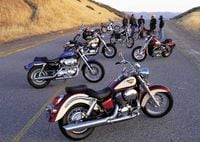
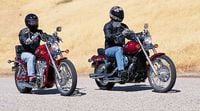
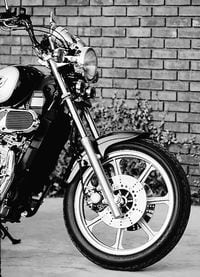
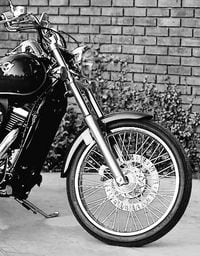
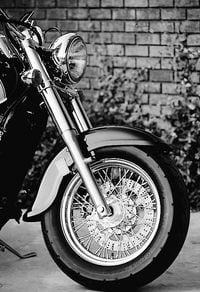
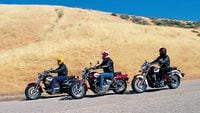
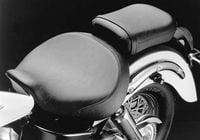
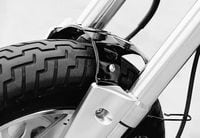
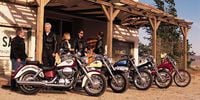
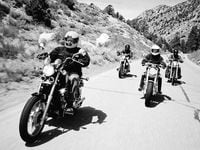
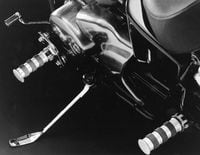
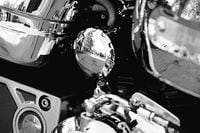
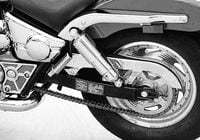
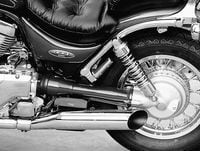
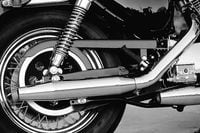
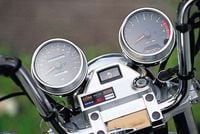
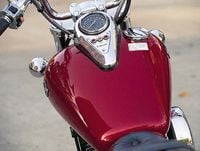
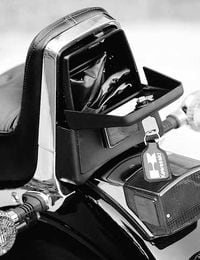
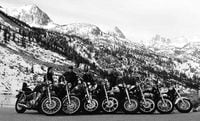
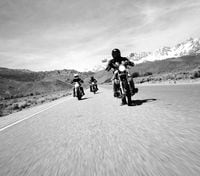
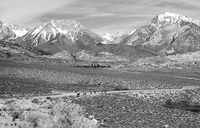
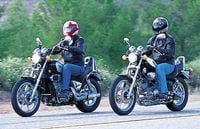
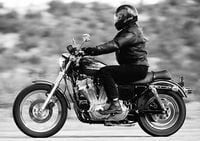
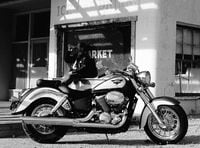
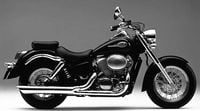
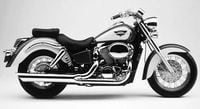
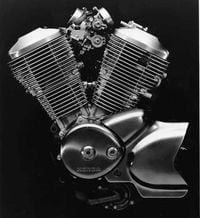
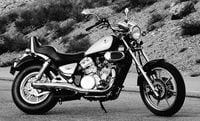

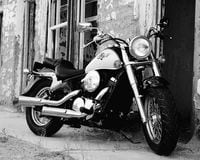
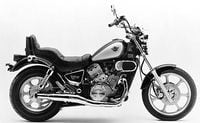
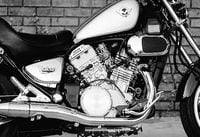
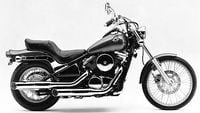
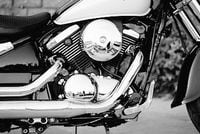
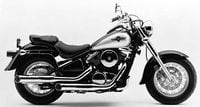
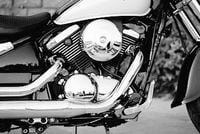
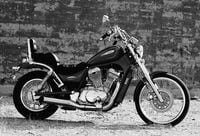
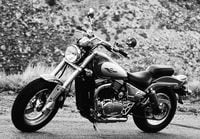
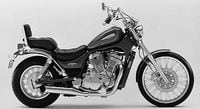
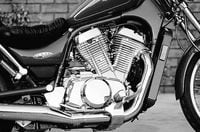
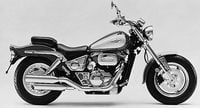
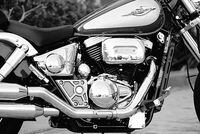
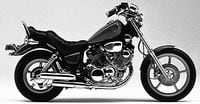
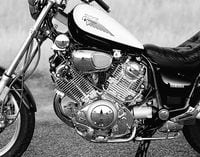
/cloudfront-us-east-1.images.arcpublishing.com/octane/H6Z2IC7WYRBXZNQS4MI3SZ5KPQ.jpg)
/cloudfront-us-east-1.images.arcpublishing.com/octane/IWO5T5PBT5E4HFQ5GK47H5YXR4.jpg)
/cloudfront-us-east-1.images.arcpublishing.com/octane/OQVCJOABCFC5NBEF2KIGRCV3XA.jpg)
/cloudfront-us-east-1.images.arcpublishing.com/octane/F3O2DGLA4ZBDJGNVV6T2IUTWK4.jpg)
/cloudfront-us-east-1.images.arcpublishing.com/octane/ZXYQE3MHLFDSPKNGWL7ER5WJ4U.jpg)
/cloudfront-us-east-1.images.arcpublishing.com/octane/RDF24VM7WVCOBPIR3V3R4KS63U.jpg)
/cloudfront-us-east-1.images.arcpublishing.com/octane/W7RSIBFISNHJLIJESSWTEBTZRQ.jpg)
/cloudfront-us-east-1.images.arcpublishing.com/octane/AERA26ENRNBW3K324YWCPEXYKM.jpg)
/cloudfront-us-east-1.images.arcpublishing.com/octane/YWX3YX7QBBHFXFDMEEEKRG4XJE.jpg)
/cloudfront-us-east-1.images.arcpublishing.com/octane/I7OKI53SZNDOBD2QPXV5VW4AR4.jpg)
/cloudfront-us-east-1.images.arcpublishing.com/octane/IH52EK3ZYZEDRD3HI3QAYOQOQY.jpg)
/cloudfront-us-east-1.images.arcpublishing.com/octane/K2FSAN7OWNAXRJBY32DMVINA44.jpg)
/cloudfront-us-east-1.images.arcpublishing.com/octane/G4XK7JL24FCUTKLZWUFVXOSOGE.jpg)
/cloudfront-us-east-1.images.arcpublishing.com/octane/JJNXVAC27ZCDDCMTHTQZTHO55Y.jpg)
